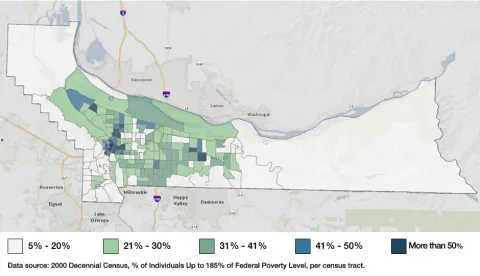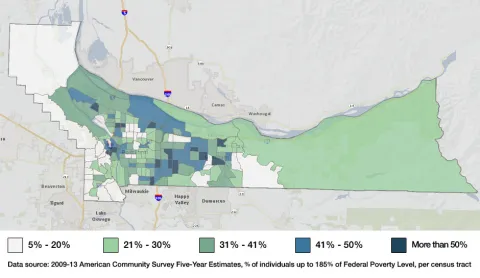Published: March 2015
Introduction & Objectives
There have been demonstrable population changes in Multnomah County over the last 10 years, including a change in the concentration of some of our most vulnerable residents. Exhibits 1 and 2 show changes in areas of the County with the highest percentage of residents who are at or below 185% of the federal poverty level.
Exhibit 1: Poverty by Multnomah County Census Tracts, per 2000 Decennial Census

Exhibit 2: Poverty by Multnomah County Census Tracts, per 2009-13 American Community Survey

These demographic changes prompted the County Auditor to examine the extent to which service distribution is equitable. The objectives of this audit were to identify
- the extent to which County service delivery is mirroring population changes,
- County efforts to match services to intended service recipients and
- barriers to achieving these goals.
Results
County program service distribution generally mirrors the location of intended service recipients. To the extent possible, County programs are adjusting delivery systems to better meet clients where they live. The extent to which County programs are able to match services to intended recipients depends on how accurately they understand where their populations are located and the barriers they face in attempting to reach them.
- County programs are generally well positioned to deliver services to the populations they intend to serve. Community and home-based service delivery has broadened the reach of many programs beyond more visible County and contractor facilities. Programs may include fixed and mobile services, and some programs include culturally specific services that function Countywide to reach target populations.
- County programs are aware of the changing demographics in different areas of Multnomah County. Programs use a variety of methods to determine where eligible clients live and are best able to access available services. In many cases, the programs take advantage of Geographic Information System (GIS) resources available within the County to map client populations, eligible populations and service locations. Other programs collect survey data, data from police departments, or the State of Oregon. Where programs have expanded service distribution, they appeared to have done so in areas that had experienced recent population growth and/or shifts.
- Limited resources are the most common barrier facing County programs as they attempt to reach their intended service recipients.
- Community partner capacity limitations also have a significant impact on service provision.
